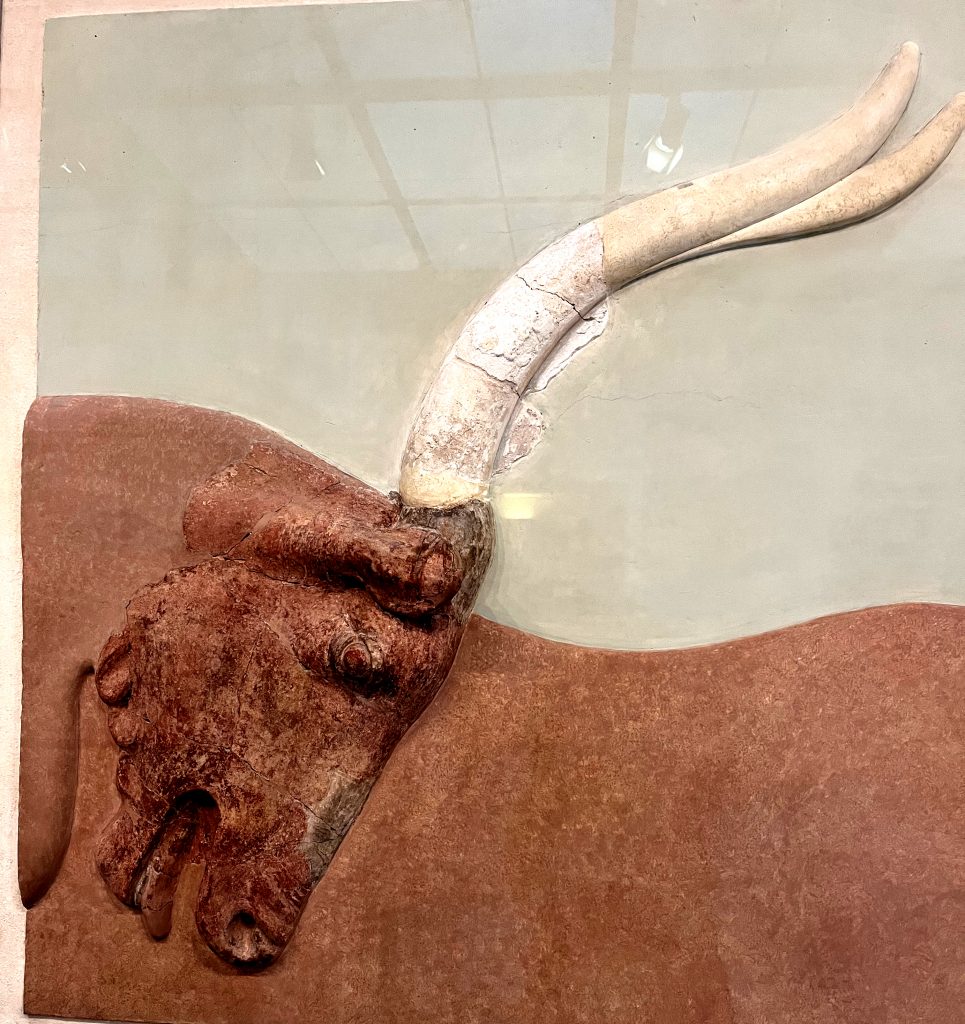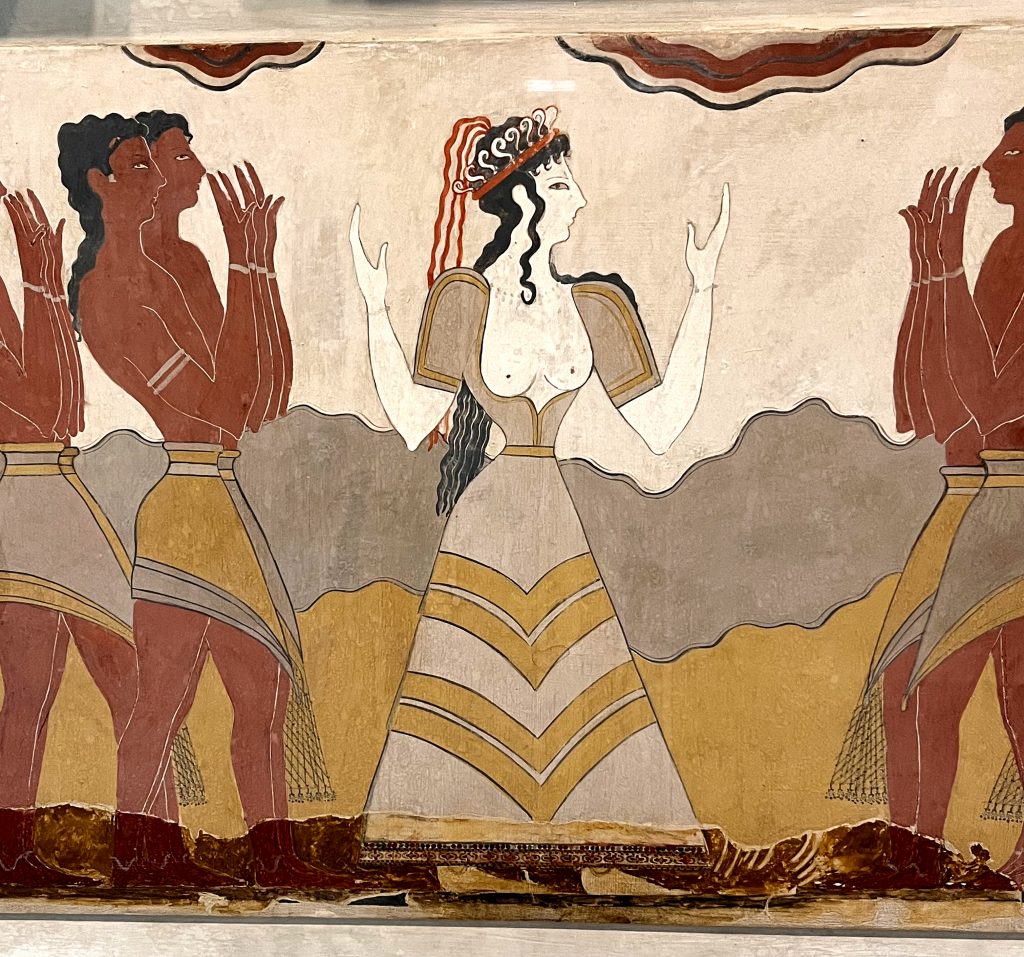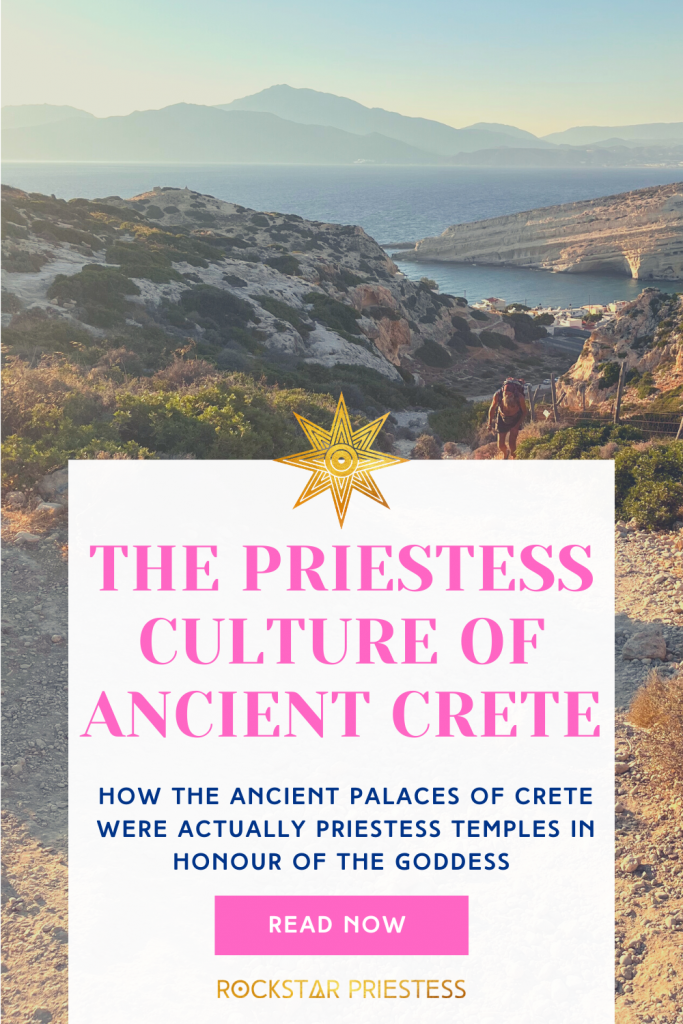I have just returned from two weeks visiting temples and sacred sites on the greek island of Crete, and it was such a magical experience! It’s truly a dream destination for anyone who is in love with the goddess.
But why is Crete such a powerful pilgrimage site for Goddess folk…
… and why have we never heard about it before?
Why Crete?
Just over 100 years ago, a British archaeologist called Sir Arthur Evans went to Crete in search of the mythological King Minos. He figured that the stories and mythologies of King Minos, the yearly tribute of seven athenian boys and girls and the terrifying half man half bull Minotaur and the labyrinth he lived in must have some real-world parallel, so he went a-hunting on the island of Crete.
He chose Crete because some really interesting seal stones and ancient coins, and took over uncovering the site of Knossos from a greek archaeologist called Minos Kalokairinos.
Can you imagine how much he must have wet his pants with excitement when he and his archeological team discovered this huge three and a half thousand year old carving of a bull at his excavations at Knossos?

As the archeologists dug, they uncovered something surprising – a huge labyrinthine complex with endless rooms, storage magazines, stair cases, twisting winding walkways… was this the labyrinth talked about in the ancient myths?
What’s more, there were LOTS of these huge buildings, all across the country of Crete, and they were from a time long before anything they had known about before – a lost civilisation.
Sir Arthur Evans was looking for a King, and his eyes, he found it. He already had a story that he wanted to fit his discoveries into, so he did – he declared these complexes to be palaces, the central rooms with stone benches and a carved stone seat to be the throne room, and decided that this was the culture and civilisation of King Minos, thus, the Minoan Civilisation.
But, he got it wrong.
Here’s the thing – all we have ever known is our current patriarchal culture, so that’s the only lens we see things through. We look at everything though the lens of power-over, of kings and armies, of dominance and men being better/more powerful than women.
We think that’s the only way things can be.
Arthur Evans thought that was the only way things can be.
And when we look at the stories that inspired him to search for this war-like king, we see that they also come from a patriarchal culture that can only understand through the lens of kings and power over and patriarchy.
The earliest stories of King Minos are in the Iliad, and the earliest version of this dates to the 8th century BC – some 600 years after the end of the Minoan culture – and this ancient greek society was already heavily patriarchal with kings and conquerers. You only have to look at the story and perceptions of the Iliad to see the war-obsessed, Zeus-is-the-leader-and-he’s-an-asshole, women-hating culture that birthed it.
(Sorry classical history buffs. I just can’t forgive the Iliad for how dismissive of Aphrodite it was.)
But.
🏛 There are no images, statues or names of kings found from the Minoan culture. I mean, you know kings, right? They want their name and face on everything. Think of Rameses the Great in Egypt, popping up big statues of himself wherever he went. Think of the lines and lineages that kings like to keep to prove their legitimacy. In a society built around the glorification of one man… surely there would be some actual evidence of that one man?
🏛 Our evidence that these great buildings are Palaces is that they are very big and they all have these weird fancy rooms in them with benches for people to possibly sit on.
🏛… and our evidence that this civilisation was ruled by a king is from a myth that was written down 600 years after the collapse of the civilisation. (Also in this myth, the king was a son of Zeus and his daughter had sex with a bull to give birth to a minotaur. I mean, obviously there is a lot of this story we can’t take literally.)
Do you know what we have instead of evidence for kings, though?
Evidence for PRIESTESSES.
At the huge complex of Knossos, the first palace to be uncovered in 1900 and thought to be a cultural centre of the Minoan culture for several thousand years, we don’t have paintings of kings but paintings of WOMEN.
We have statues of bare breasted women holding snakes – seals depicting goddesses and priestesses – images of women dancing, women being at the centre of the festivities, and women being revered and honoured.

Women performing death rites. Women receiving the epiphany of the Goddess. Women leading ritual. Women being brought chalices. Women in procession.
At all the other “palace” sites across Crete (and there are lots of sites very like Knossos – Malia, Phaistos, Zakros, Gournia, Moklos etc) we have exactly the same thing. No kings, but lots of women. Lots of priestesses.
And, at Phaistos, we have something called the Phaistos Disk, a three and a half thousand year old inscription in a forgotten language, that has finally been translated and is literally an invocation prayer to a goddess.
These palaces are not palaces.
They are temples.
And they were not ruled by Kings with an iron fist.
They were lead by Priestesses.
The Minoan Culture is the last fully Goddess-centred culture in Europe. A successful culture formed of lots of abundant and prosperous temple towns that all worked together in harmony – there is no evidence of war between these temple towns. A culture whose artistic skill was celebrated throughout the Mediterranean, near east and Egypt.
And at the centre of community life were the priestesses. Not one fancy priestess – we don’t think we have any specific names or venerations of particular priestesses – but the community of priestesses.
I think that this society was not about the cult of the individual, but was entirely about community. It wasn’t about individuating yourself, making yourself more special or powerful or more important than other people – it was about the group, not the glory of one person.
(Where am I getting that from? Group grave sites. Lack of kings. The openness of the temple layout – for example, in Zakros round the back of the fanciest temple rooms are the houses of the everyday people in town, and every temple has a whole bunch of different entrances leading directly to the central courtyard. The storage jars that suggest that the temple was perhaps also an administrative centre where goods could be shared out. The symbolic way men and women are drawn – they don’t seem to be individuals, they seems to be roles as they are all wearing/doing the same thing. No wars. And no “Jared-woz-ere” or “Jessica-the-mightiest-priestess” kind of inscriptions found yet.)
VERY different to the idea of a king, huh?
And very different for anything we can understand or get behind today.
That’s why Crete is such a powerful pilgrimage site for goddess-loving folk in the modern world – we get to immerse ourselves in the sacred sites of a culture that loved the goddess and surround ourselves with history that says YES, you are NOT CRAZY, peaceful earth-honouring goddess cultures DID EXIST.
So incredible.
Next time I’ll tell you a little more about the temples I visited and the vibes I felt from these ancient sacred places!
Want to read the rest of my blog posts about Crete and the ancient goddess sits of the Minoans?
You can read them here:
(List coming soon!)
P.S. Do you dream of going on a priestess pilgrimage to crete, visiting the museums, going to the secret temples and ancient priestess sites? My girl Katinka Soetens runs an incredible tour of Crete every year, I have done it twice and it’s phenomenal. Registration is not open for the 2023 tour yet, but you can get in touch with her here and get on the waitlist.


